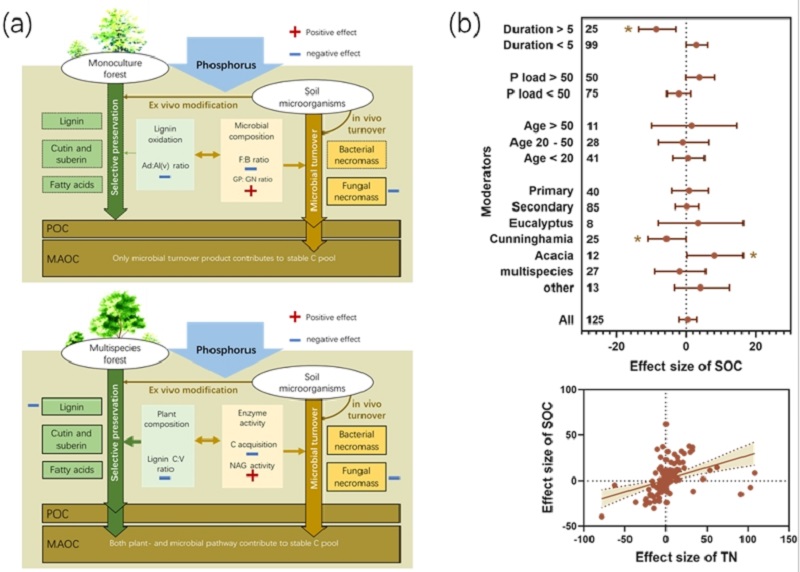South China Botanical Garden reveals the mechanism of forest types regulating soil organic carbon compounds in response to exogenous phosphorus addition
Tropical forests are sensitive to exogenous nutrient input. The relative availability of phosphorus (P) compared to nitrogen (N) thus plays a vital role in tropical carbon (C) budget, yet how nutrient availability regulates the conversion between sink and source in tropical forest soil organic carbon (SOC) remains uncertain. Through the biochemical selecting process, plant-derived complex compounds and large molecular products by microbial turnover can be sustained in the soil and contribute to SOC preservation. However, the variation of SOC preserving mechanism under nutrient application awaits to be explored.
Restoration Ecology Team of South China Botanical Garden, CAS, conducted two long-term nutrient addition experiments in a monoculture plantation at the Heshan National Field Research Station of Forest Ecosystems (22°34′N; 112°50′E) and a secondary multispecies forest at the Xiaoliang Research Station of Tropical Coastal Ecosystems (21°27′N, 110°54′E). Researchers analyzed specific fingerprints of plant- and microbial-derived SOC compounds to reveal the forest-specific SOC preservation via biochemical selection in response to nutrient application. In addition, researchers conducted a meta-analysis by compiling 125 paired measurements in field experiments from 62 studies to quantify the effect of P application on SOC content among tropical forest ecosystems.
The results showed that bulk SOC content at 0-20 cm depth had a neutral response to P addition in two forests, the same with the meta-analysis. However, microbial community composition and activity explained divergent responses of SOC compounds to P addition in two forests. With low-quality plant substrates in the monoculture plantation, P addition shifted soil microbial community composition and accelerated consumption of microbial residual C (MRC) as C source for microbes; in comparison, P addition increased plant species with less complex lignin substrates and induced microbial acquisition for N sources, thus stimulated the decomposition of both lignin and MRC. SOC compounds with biotic origins, especially fungal MRC, had close associations with mineral-associated organic C in the multispecies forest. Therefore, the reduction of fungal MRC by chronic P addition suggested a detrimental impact on SOC accumulation and stability in tropical multispecies forests.
The study entitled “Responses of soil organic carbon compounds to phosphorus addition between tropical monoculture and multispecies forests” was published online in Science of the Total Environment. This study was financially supported by the Key Technologies R&D Program of Guangdong Province, the National Natural Science Foundation of China, etc. The article link is: https://doi.org/10.1016/j.scitotenv.2024.174672
Prof. Yue Li is a biogeochemist in South China Botanical Garden, Chinese Academy of Sciences. E-mail: liyue@scbg.ac.cn ; Tel : 020-37252711.

Fig 1. The mechanisms of biotic-derived soil organic carbon compounds in response to exogenous phosphorus addition between subtropical monoculture and multispecies forests.
File Download: